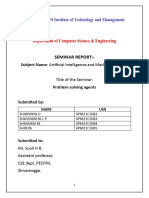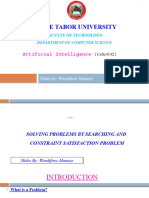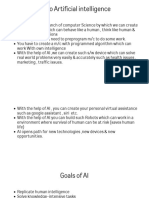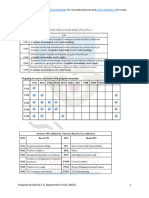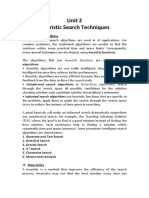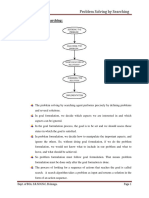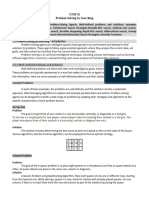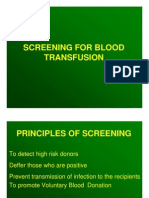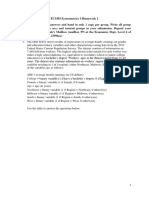0 ratings0% found this document useful (0 votes)
30 viewsSolving Problems by Searching
Solving Problems by Searching
Uploaded by
oromafi tubeThis document discusses problem-solving agents and search algorithms. It describes problem-solving agents as goal-based agents that consider future actions and outcomes to achieve goals. The document then provides an example of an agent trying to get from Arad to Bucharest in Romania. It defines the components of a well-defined problem - initial state, actions, transition model, goal test, and path cost. Finally, it introduces uninformed search strategies like breadth-first search and depth-first search that search the problem space without heuristics.
Copyright:
© All Rights Reserved
Available Formats
Download as PPTX, PDF, TXT or read online from Scribd
Solving Problems by Searching
Solving Problems by Searching
Uploaded by
oromafi tube0 ratings0% found this document useful (0 votes)
30 views27 pagesThis document discusses problem-solving agents and search algorithms. It describes problem-solving agents as goal-based agents that consider future actions and outcomes to achieve goals. The document then provides an example of an agent trying to get from Arad to Bucharest in Romania. It defines the components of a well-defined problem - initial state, actions, transition model, goal test, and path cost. Finally, it introduces uninformed search strategies like breadth-first search and depth-first search that search the problem space without heuristics.
Original Title
chapter 3
Copyright
© © All Rights Reserved
Available Formats
PPTX, PDF, TXT or read online from Scribd
Share this document
Did you find this document useful?
Is this content inappropriate?
This document discusses problem-solving agents and search algorithms. It describes problem-solving agents as goal-based agents that consider future actions and outcomes to achieve goals. The document then provides an example of an agent trying to get from Arad to Bucharest in Romania. It defines the components of a well-defined problem - initial state, actions, transition model, goal test, and path cost. Finally, it introduces uninformed search strategies like breadth-first search and depth-first search that search the problem space without heuristics.
Copyright:
© All Rights Reserved
Available Formats
Download as PPTX, PDF, TXT or read online from Scribd
Download as pptx, pdf, or txt
0 ratings0% found this document useful (0 votes)
30 views27 pagesSolving Problems by Searching
Solving Problems by Searching
Uploaded by
oromafi tubeThis document discusses problem-solving agents and search algorithms. It describes problem-solving agents as goal-based agents that consider future actions and outcomes to achieve goals. The document then provides an example of an agent trying to get from Arad to Bucharest in Romania. It defines the components of a well-defined problem - initial state, actions, transition model, goal test, and path cost. Finally, it introduces uninformed search strategies like breadth-first search and depth-first search that search the problem space without heuristics.
Copyright:
© All Rights Reserved
Available Formats
Download as PPTX, PDF, TXT or read online from Scribd
Download as pptx, pdf, or txt
You are on page 1of 27
Chapter 3
Solving Problems by Searching
In which we see how an agent can find a sequence of actions that achieves its
goals when no single action will do.
In chapter 2 discussed simplest agent were reflex agents.
Such agents cannot operate well in environments for which this
mapping would be too large to store and would take too long to
learn.
Goal-based agents, on the other hand, consider future actions and
the desirability of their outcomes.
Conti ..
This chapter describes one kind of goal-based agent called a problem-solving agent .
Problem Solving Agents
Intelligent agents are supposed to maximize their performance measure.
Imagine an agent in the city of Arad, Romania, enjoying a touring holiday.
The agent’s performance measure contains many factors:
It wants to improve its suntan
improve its Romanian
take in the sights
enjoy the nightlife (such as it is)
avoid hangovers, and so on.
Conti ..
Now, suppose the agent has a nonrefundable ticket to fly out of
Bucharest the following day.
In that case, it makes sense for the agent to adopt the goal of getting
to Bucharest.
Goal formulation, based on the current situation and the agent’s
performance measure, is the first step in problem solving.
Goals task is to find how to act, now and in the future, so that it
reaches a goal state
Problem formulation is the process of deciding what actions
and states to consider, given a goal.
Our agent has now adopted the goal of driving to Bucharest and is
considering where to go from Arad.
Three roads lead out of Arad, one toward Sibiu, one to Timisoara,
and one to Zerind. None of these achieves the goal.
Suppose that the agent has map Romania.
Conti ..
The agent can use information to consider subsequent stages of a
hypothetical journey via each of the three towns, trying to find a journey
that eventually gets to Bucharest.
an agent with several
immediate options of unknown value can decide what to do by first examining future
actions
that eventually lead to states of known value.
For now we assume that the environment is observable, so the agent
always knows the current state, indicating its presence to arriving drivers.
Conti …
We also assume the environment is discrete, so at any given state
there are only finitely many actions to choose from.
We will assume the environment is known, so the agent knows which
states are reached by each action.
Finally, we assume that the environment is deterministic, so each
action has exactly one outcome.
Under ideal conditions, this is true for the agent in Romania.
Under these assumptions, the solution to any problem is a fixed
sequence of actions.
Conti ..
The process of looking for a sequence of actions that reaches the goal
is called search.
A search algorithm takes a problem as input and returns a solution in
the form of an action sequence.
Once a solution is found, the actions it recommends can be carried
out is called the execution phase.
After formulating a goal and a problem to solve, the agent calls a
search procedure to solve it.
Once the solution has been executed, the agent will formulate a new
goal.
Conti ..
Notice that while the agent is executing the solution sequence it
ignores its percepts when choosing an action because it knows in
advance what they will be.
Well-defined problems and solutions
A problem can be defined formally by five components:
The initial state that the agent starts in. For example, the initial state for our
agent in Romania might be described as In(Arad).
Conti ..
A description of the possible actions available to the agent. state s,
actions(s) returns the set of actions that can be executed in s.
We say that each of these actions is applicable in s. For example,
from the state In(Arad), the applicable actions are {Go(Sibiu),
Go(Timisoara), Go(Zerind)}.
A description of what each action does; the formal name for this is
the transition model, specified by a function RESULT(s, a) that returns
the state that results from doing action a in state s.
We also use the term successor to refer to any state reachable from a
given state by a single action.
For example, we have RESULT(In(Arad),Go(Zerind)) = In(Zerind) .
Conti ..
Together, the initial state, actions, and transition model implicitly
define the state space of the problem, the set of all states reachable
from the initial state by any sequence of actions.
The state space forms a directed network or graph in which the
nodes are states and the links between nodes are actions.
A path in the state space is a sequence of states connected by a
sequence of actions.
The goal test, which determines whether a given state is a goal state.
The agent’s goal in Romania is the singleton set {In(Bucharest )}.
Conti ..
Conti ..
A path cost function that assigns a numeric cost to each path.
The problem-solving agent chooses a cost function that reflects its
own performance measure.
The preceding elements define a problem and can be gathered into a
single data structure that is given as input to a problem-solving
algorithm.
A solution to a problem is an action sequence that leads from the
initial state to a goal state.
Solution quality is measured by the path cost function, and an
optimal solution has the lowest path cost among all solutions.
Conti ..
Formulating problems
In the preceding section we proposed a formulation of the problem
of getting to Bucharest in terms of the initial state, actions, transition
model, goal test, and path cost.
Example Problems
Toy problems
Conti ..
States: A state description specifies the location of each of the eight tiles and the blank
in one of the nine squares.
Initial state: Any state can be designated as the initial state. Note that any given goal
can be reached from exactly half of the possible initial states (Exercise 3.4).
Actions: The simplest formulation defines the actions as movements of the blank space
Left, Right, Up, or Down. Different subsets of these are possible depending on where
the blank is.
Transition model: Given a state and action, this returns the resulting state; for example,
if we apply Left to the start state in Figure 3.4, the resulting state has the 5 and the
blank
switched.
Goal test: This checks whether the state matches the goal configuration shown in Figure
3.4. (Other goal configurations are possible.)
Path cost: Each step costs 1, so the path cost is the number of steps in the path.
States: Any arrangement of 0 to 8 queens on the board is a state.
Initial state: No queens on the board.
Actions: Add a queen to any empty square.
Transition model: Returns the board with a queen added to the
specified square.
Goal test: 8 queens are on the board, none attacked.
Measuring problem-solving performance
Completeness: Is the algorithm guaranteed to find a solution when
there is one?
Optimality: Does the strategy find the optimal solution?
Time complexity: How long does it take to find a solution?
Space complexity: How much memory is needed to perform the
search?
Searching for solution
Having formulated some problems, we now need to solve them.
A solution is an action sequence, so search algorithms work by
considering various possible action sequences.
The possible action sequences starting at the initial state form a
search tree with the initial state at the root.
the branches are actions and the nodes correspond to states in the
state space of the problem.
Conti ..
Infrastructure for search algorithms
Search algorithms require a data structure to keep track of the search
tree that is being constructed.
For each node n of the tree, we have a structure that contains four
components:
n.STATE: the state in the state space to which the node corresponds.
n.PARENT: the node in the search tree that generated this node.
n.ACTION: the action that was applied to the parent to generate the node.
n.PATH-COST: the cost, traditionally denoted by g(n), of the path from the
initial state to the node, as indicated by the parent pointers.
Conti ..
UNINFORMED SEARCH STRATEGIES
Called blind search
The term means that the strategies have no additional information
about the states beyond that provided in the problem definition.
All strategies are distinguished by the order in which nodes are
expanded.
Strategies that know whether one non-goal state is “more promising”
than other are called informed search or heuristic search strategies.
1. Breadth-first search
Is a simple strategy in which the root node is expanded first,
then all the successors of the root node are expanded next,
then their successors, and so on.
All the nodes are expanded at a given depth in the search tree
before any nodes at the next level are expanded.
Breadth-first search is an instance of the general graph-search
algorithm in which the shallowest unexpanded node is chosen
for expansion.
This is achieved very simply by using a FIFO queue for the
frontier.
Conti .
2. Depth-first Search
Depth-first search always expands the deepest node in the current
frontier of the search tree.
The search proceeds immediately to the deepest level of the search
tree, where the nodes have no successors.
Conti ..
You might also like
- Simulation of PMSM Speed Control System-53291344Document6 pagesSimulation of PMSM Speed Control System-53291344Mmahm 1238No ratings yet
- Unit II Sub: Artificial Intelligence Prof Priya SinghDocument25 pagesUnit II Sub: Artificial Intelligence Prof Priya SinghAbcdNo ratings yet
- Searching Algorithms-Problem Solving in AIDocument16 pagesSearching Algorithms-Problem Solving in AIsangayashwanth205No ratings yet
- Module 2Document115 pagesModule 2J Christopher ClementNo ratings yet
- Unit 2 - 1Document13 pagesUnit 2 - 1jidey30017No ratings yet
- 5 Solving Problems by SearchingDocument80 pages5 Solving Problems by Searching219X1A3359 SINGASANI JAYA PRATHAP REDDYNo ratings yet
- 4 - C Problem Solving AgentsDocument17 pages4 - C Problem Solving AgentsPratik RajNo ratings yet
- Unit IiDocument39 pagesUnit IiAditya MishraNo ratings yet
- Ai - Chapter 3Document10 pagesAi - Chapter 3sale msgNo ratings yet
- Aiml 6Document8 pagesAiml 6Suma T KNo ratings yet
- Chapter - 3 Searching and PlanningDocument85 pagesChapter - 3 Searching and PlanningBeky KitawmNo ratings yet
- AIT307 IAI Unit2 1Document60 pagesAIT307 IAI Unit2 1Prem Sankar ChakkingalNo ratings yet
- CS6659 & Artificial Intelligence Unit IDocument17 pagesCS6659 & Artificial Intelligence Unit IPraveena papa2712No ratings yet
- Chapter 3Document65 pagesChapter 3suhan4meNo ratings yet
- Ai Mod2 (Highlighted)Document33 pagesAi Mod2 (Highlighted)Alen EliasNo ratings yet
- UNIT-2 AI NotesDocument7 pagesUNIT-2 AI Notesabhiramsurya48No ratings yet
- Intro AI(BTF306) Unit 2 (1)Document67 pagesIntro AI(BTF306) Unit 2 (1)Aarushi SabooNo ratings yet
- Solving Problems by Searching: Reflex Agent Is SimpleDocument91 pagesSolving Problems by Searching: Reflex Agent Is Simplepratima depaNo ratings yet
- Lecture5 - 6 Ch3Document87 pagesLecture5 - 6 Ch3moonali77735No ratings yet
- AI Chapter+3 1Document15 pagesAI Chapter+3 1Ammar MousaNo ratings yet
- NetworkingDocument23 pagesNetworkingteshu wodesaNo ratings yet
- AI Chapter 3Document36 pagesAI Chapter 3Mulugeta HailuNo ratings yet
- Chapter 3Document80 pagesChapter 3Estefen ErmiasNo ratings yet
- AI Module 2 NotesDocument16 pagesAI Module 2 NoteshitobyeNo ratings yet
- My AI CH 3Document27 pagesMy AI CH 3Dawit BeyeneNo ratings yet
- PAI Module 2Document15 pagesPAI Module 2rekharaju041986No ratings yet
- Lecture Notes - 7Document8 pagesLecture Notes - 712112004itNo ratings yet
- SearchDocument11 pagesSearchtoysy2020No ratings yet
- AI Unit 2 NotesDocument10 pagesAI Unit 2 NotesSatya NarayanaNo ratings yet
- Unit 2Document69 pagesUnit 2jana kNo ratings yet
- Searching in Problem Solving AI - PPTX - 20240118 - 183824 - 0000Document57 pagesSearching in Problem Solving AI - PPTX - 20240118 - 183824 - 0000neha praveenNo ratings yet
- Introduction With Artificial IntelligenceDocument95 pagesIntroduction With Artificial Intelligencekaustubhwani155No ratings yet
- Solving Problems by SearchingDocument82 pagesSolving Problems by SearchingJoyfulness EphaNo ratings yet
- Chapter 3-AIDocument26 pagesChapter 3-AIabdiaberagemechuNo ratings yet
- Chapter ThreeDocument46 pagesChapter ThreeJiru AlemayehuNo ratings yet
- Unit II SOLVING PROBLEMS BY SEARCHINGDocument63 pagesUnit II SOLVING PROBLEMS BY SEARCHINGPallavi BhartiNo ratings yet
- AI Assignment 1Document13 pagesAI Assignment 1Abhinav PandeyNo ratings yet
- Chapter2 Notes NEPDocument17 pagesChapter2 Notes NEPsahilmalekoppa786No ratings yet
- Ai Module-2notesDocument32 pagesAi Module-2notes22br14851No ratings yet
- IT314 Week6aDocument30 pagesIT314 Week6aMuhammad Rahman BangashNo ratings yet
- Ai-Unit 2Document31 pagesAi-Unit 2vishalap775No ratings yet
- Module 2Document16 pagesModule 2jagig81645No ratings yet
- Unit 2 SearchDocument51 pagesUnit 2 Searchujjawalnegi14No ratings yet
- CH 3 SearchingDocument18 pagesCH 3 SearchingYonatan GetachewNo ratings yet
- Bai402 Aimod2notesDocument17 pagesBai402 Aimod2notesjpnd1508No ratings yet
- AI - AssignmentDocument14 pagesAI - AssignmentlmsrtNo ratings yet
- Module 2 Principle of AIDocument15 pagesModule 2 Principle of AItrrishikesh2004No ratings yet
- @vtucode - in BAD402 Module 2 AI&ML 2022 SchemeDocument15 pages@vtucode - in BAD402 Module 2 AI&ML 2022 Schemeriyazahmedkhan2710No ratings yet
- Unit 2 AIDocument14 pagesUnit 2 AIPriyankaNo ratings yet
- Unit 2 AIDocument19 pagesUnit 2 AIabhiramsurya48No ratings yet
- AI Module2Document53 pagesAI Module2goudasanjay09No ratings yet
- Ai Unit IiDocument31 pagesAi Unit Iisangayashwanth205No ratings yet
- AI Lecture 03 (Uninformed Search)Document43 pagesAI Lecture 03 (Uninformed Search)Bishowjit DattaNo ratings yet
- Searching in AiDocument15 pagesSearching in AiRohan KumarNo ratings yet
- AI Unit-2 NotesDocument22 pagesAI Unit-2 NotesRajeev SahaniNo ratings yet
- Lec3-Problem Solving AgentsDocument19 pagesLec3-Problem Solving AgentsÀbdUŁ ßaŠiŤNo ratings yet
- Module 2 AiDocument40 pagesModule 2 AiNorah ElizNo ratings yet
- Assignment_AI(Rohan)(1)Document24 pagesAssignment_AI(Rohan)(1)chessyrohanNo ratings yet
- Unit 2 Hill Climbing TechniquesDocument23 pagesUnit 2 Hill Climbing Techniquesharshita.sharma.phd23No ratings yet
- Unit II - Problem Solving by SearchingDocument21 pagesUnit II - Problem Solving by SearchingYashaswini GowdaNo ratings yet
- Final Draft of Moral and Citizenship Education-1Document208 pagesFinal Draft of Moral and Citizenship Education-1oromafi tubeNo ratings yet
- Chapter-2 Propositional Logic: Valid ArgumentsDocument7 pagesChapter-2 Propositional Logic: Valid Argumentsoromafi tubeNo ratings yet
- Unit - 4: Design ProcessDocument28 pagesUnit - 4: Design Processoromafi tubeNo ratings yet
- Global Affairs Module PDFDocument151 pagesGlobal Affairs Module PDFDamena100% (2)
- Unit - 3: The InteractionDocument23 pagesUnit - 3: The Interactionoromafi tubeNo ratings yet
- Department of Management College of Business and Economics Mekelle University Mathematics For Management WorksheetDocument4 pagesDepartment of Management College of Business and Economics Mekelle University Mathematics For Management Worksheetoromafi tubeNo ratings yet
- Database Security and AuthorizationDocument17 pagesDatabase Security and Authorizationoromafi tubeNo ratings yet
- Analisis Farmasi Dasar - 1 REVDocument126 pagesAnalisis Farmasi Dasar - 1 REVBadzlinaKhairunizzahra100% (1)
- Augmentation of The Sinus Floor With Mandibular Bone Block and Simultaneous Implantation: A 6-Year Clinical InvestigationDocument8 pagesAugmentation of The Sinus Floor With Mandibular Bone Block and Simultaneous Implantation: A 6-Year Clinical InvestigationWesley Silva100% (1)
- Narrative EssayDocument2 pagesNarrative EssayRareș PopaNo ratings yet
- T S Eliot-Popular CultureDocument16 pagesT S Eliot-Popular Culturebharan16No ratings yet
- Screening For Blood TransfusionDocument18 pagesScreening For Blood Transfusionapi-3823785No ratings yet
- Göbekli Tepe - The Stone Age Sanctuaries. New Results of Ongoing Excavations With A Special Focus On Sculptures and High ReliefsDocument18 pagesGöbekli Tepe - The Stone Age Sanctuaries. New Results of Ongoing Excavations With A Special Focus On Sculptures and High Reliefsfrancisco.fazenda.fernandesNo ratings yet
- Smith ChartDocument11 pagesSmith ChartBill WhiteNo ratings yet
- TrigonometryDocument11 pagesTrigonometryFun PlanetNo ratings yet
- Unit 1: Persisting and Securing Messages: Week 2: Expand Your SkillsDocument100 pagesUnit 1: Persisting and Securing Messages: Week 2: Expand Your Skillsmeenakshi2419No ratings yet
- Stability Analysis of Small DamsDocument6 pagesStability Analysis of Small DamsPrabhav Mishra100% (1)
- Online Workbooks Teachers' Guide: Student ExperienceDocument21 pagesOnline Workbooks Teachers' Guide: Student ExperienceIrguensNo ratings yet
- How To Draw Piping IsometricsDocument18 pagesHow To Draw Piping IsometricsEmavwodia Solomon100% (1)
- Kryss-Mark-Francisco Module 4 and 5 IOMDocument24 pagesKryss-Mark-Francisco Module 4 and 5 IOMChellemark FranciscoNo ratings yet
- Quiz IiiDocument2 pagesQuiz IiiLanCicakNo ratings yet
- بايو عملي ٢Document8 pagesبايو عملي ٢rkfw7nq7xrNo ratings yet
- New Recommendations According To 2022 ILCOR CoSTDocument1 pageNew Recommendations According To 2022 ILCOR CoSTMineTagraNo ratings yet
- Bsbmgt605b Provide Leadership Across The OrganisationDocument4 pagesBsbmgt605b Provide Leadership Across The OrganisationUmit OrhunNo ratings yet
- Outdoor Switchyards: Slide - 1Document25 pagesOutdoor Switchyards: Slide - 1Somnath Das100% (2)
- 19228Document549 pages19228Sachindra RaoNo ratings yet
- Black Box CatalogDocument116 pagesBlack Box CatalogAnonymous nC9gpUWPNo ratings yet
- Loving You From The PastDocument2 pagesLoving You From The PastFritzie Denila-VeracityNo ratings yet
- If Clause or The Conditional 2023-2024 DR LAHMER MDocument8 pagesIf Clause or The Conditional 2023-2024 DR LAHMER MsolekeNo ratings yet
- Homework 2Document9 pagesHomework 2Madeleine YanNo ratings yet
- Lijphart Constitutional Choices For New DemocraciesDocument15 pagesLijphart Constitutional Choices For New DemocraciesOSMAN FEDAINo ratings yet
- Gynecological History Taking and ExaminationDocument17 pagesGynecological History Taking and Examinationnmsiswaridewi100% (1)
- Article Tanjung Pelepas Port From Jungle To Malaysia Newest Container Port 80 01Document10 pagesArticle Tanjung Pelepas Port From Jungle To Malaysia Newest Container Port 80 01Tong TonggNo ratings yet
- Periodic Table of ElementsDocument1 pagePeriodic Table of ElementsNicola ViradorNo ratings yet
- Windra Priawandiputra, Agus Dana PermanaDocument6 pagesWindra Priawandiputra, Agus Dana PermanaMokh WaginoNo ratings yet
- UGC Net SyllabusDocument3 pagesUGC Net SyllabusKaranbirNo ratings yet









